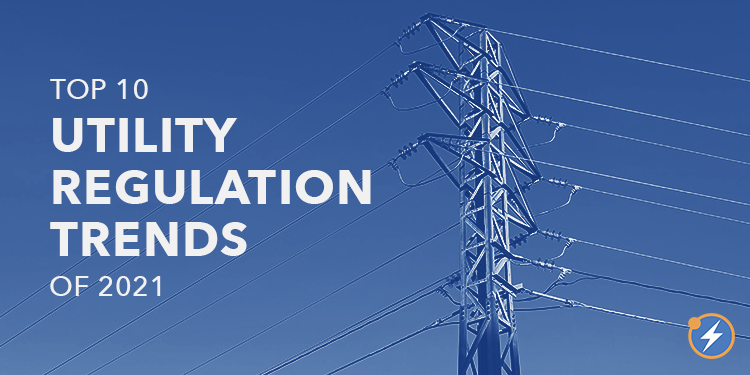Top 10 Utility Regulation Trends of 2021
December 14, 2021 at 12:45 PM / by Noah Garcia posted in PUCs, Utility, Regulatory, Wholesale Markets
Top 10 Utility Regulation Trends of 2021 – So Far
July 20, 2021 at 12:06 PM / by Noah Garcia posted in PUCs, Regulatory, Wholesale Markets
Although 2021 is only halfway through, state utility regulators and regional grid operators have had their hands full considering issues at the cutting edge of the energy transition. How can utilities develop resource plans that align with state policy goals? How do all those mobile batteries in the growing fleet of electric vehicles (EVs) get integrated with the grid? How can customers be helped to make smarter energy decisions? These questions and more are on the docket in 2021, and Advanced Energy Economy has been tracking how regulators are tackling these complex issues. Even just halfway in, the regulatory trends from across the country suggest that 2021 will be another transformational year for advanced energy.
FERC Order on EL18-178-000 Could Have Sweeping Impact
January 8, 2020 at 12:52 PM / by Eric Fitz posted in Regulatory, Insights and Analysis
Note: The original full length story can be found on blog.aee.net
A decision handed down by the Federal Energy Regulatory Commission (FERC) on a seemingly obscure issue in one regional power market threatens to have far ranging impact on the cost of electricity, the future of state policy, and the ability for advanced energy to compete – and win, as it has been doing – in the marketplace. FERC’s policy change is purportedly intended to address the “price suppression” in competitive wholesale power markets allegedly caused by resources that are supported by state policies like renewable portfolio standards (RPS) and zero emission credit (ZEC) policies. But what FERC’s decision will actually do is limit the ability of advanced energy resources to participate in the nation’s largest electricity market, force customers from New Jersey to Ohio to pay twice for the generating capacity they need, steer funds to existing coal and natural gas power plants that are otherwise redundant, and undermine state policies that are explicitly intended to promote advanced energy deployment. How it will do so is complicated, but potentially devastating to the advanced energy economy that has been steadily growing in the United States.
Summary of Top 10 Utility Regulation Trends of 2019
October 1, 2019 at 3:56 PM / by Eric Fitz posted in Regulatory, Insights and Analysis
Note the original more detailed story can be found on blog.aee.net
Top 10 regulation trends of 2019:
- 100% clean energy by…?
- Falling cost of renewables and storage driving resource plans
- Aligning utility performance with policy goals
- Utilities planning for electric transportation
- DER integration and investments in a modern grid
- Energy efficiency, load shifting, and building decarbonization
- Valuing DERs for their contributions to the grid
- Wildfire prevention and protection
- Customers making their own energy choices
- Non-wires alternative mechanisms
Why Do Public Utility Commission (PUCs) Matter?
October 1, 2019 at 3:51 PM / by Eric Fitz posted in Regulatory, Insights and Analysis
As AEE has previously discussed in detail that "Public Utility Commissions (PUCs) or their equivalent in each state serve as a replacement for the competitive market. In exchange for granting the exclusive right to sell electricity in a given service territory, PUCs determine how much the utility is allowed to invest and in what, how much it can charge, and what its profit margin can be. This is called the “regulatory compact,” and it was first laid out in the Binghamton Bridge Supreme Court case of 1865." This framework is mostly played out via recurring utility rate cases.
Not only do PUCs determine a utility’s total revenue requirement rate cases, the commissions oversee other major regulatory changes that impact over $100 billion in energy investments each year. Major policies like renewable energy portfolio standards (or now frequently called clean energy standards), energy efficiency resource standards, integrated resource plans, grid modernization, energy storage, electric vehicle, net metering and more have a massive impact on market opportunities and risks across the country.
In 2018 alone, our Trending feature helped our users identify over 50 major "Watch List" topics


/Top%2010%20Regulation%202021%20So%20Far.png)
/FERC%20PJM%20MOPR%20blog%20post-730.png)
/TOP10%202019-730.png)
/All%20AEE%20Powersuite%20Reg.%20Docket%20Topics.png)